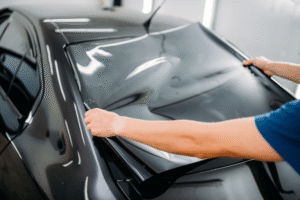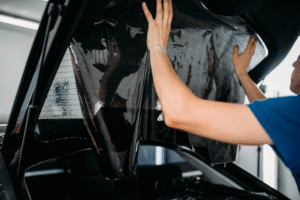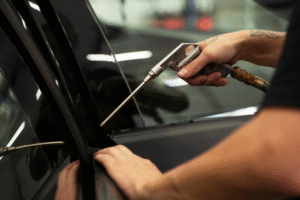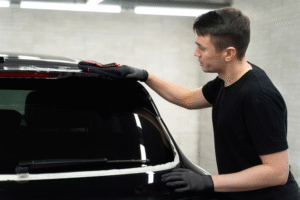Window tinting is the application of a thin laminate film to the interior (or rarely the exterior) surface of glass.
What is professional window tinting?
Professional window tinting means the job is performed by trained technicians using commercial-grade films, precision cutting tools, heat ovens, and clean-room techniques to avoid bubbles, dust, or peeling. Unlike DIY vinyl kits, professional installations are durable, often warranty-backed, and deliver measurable performance benefits in UV blocking, solar heat reduction, and safety.
This article is designed as a comprehensive resource for car owners, fleet managers, and auto enthusiasts who want to understand the real value of professional window tinting.
Benefits of Professional Window Tinting
UV Protection: Shield your health and interior
One of the most important and scientifically proven advantages of quality window film is ultraviolet (UV) protection.
- How it works: High-quality films (especially those with UV-blocking layers) absorb or reflect UVA and UVB rays before they enter the cabin.
- Why it matters for people: UV exposure contributes to skin aging and increases skin cancer risks. Tinted windows can block up to 99% of harmful UV radiation, protecting drivers and passengers.
- Why it matters for interiors: UV rays fade upholstery, dashboards, and leather. Blocking UV prevents discoloration and cracking—extending material life.
Heat Rejection & Comfort: Stay cool, save energy
Heat rejection is one of the most tangible benefits you’ll notice immediately after tinting.
- How it works: Modern films (especially ceramic and multi-layer films) reject infrared (IR) and near-infrared radiation—major contributors to interior heat—while still allowing visible light.
- Driver comfort: Cooler cabin temps reduce fatigue and make driving more comfortable on hot days.
- Energy savings: Less heat gain reduces reliance on A/C, which saves fuel (or battery in EVs), reduces wear on HVAC systems, and improves MPG/range.
- Performance metric: Look for films rated by total solar energy rejected (TSER) or solar heat gain coefficient (SHGC).
Privacy, Security & Style: Comfort + aesthetics
Tinting adds an instant visual upgrade to any vehicle while delivering functional privacy.
- Privacy: Darker films obscure the view into the cabin, protecting valuables from prying eyes—important for urban parking or ride-share vehicles.
- Security: Combined with shatter-resistant films, tinting makes rapid break-ins harder because thieves can’t easily see valuables or quickly break and grab.
- Style: Tinting gives cars a polished, cohesive appearance that many buyers find desirable—helpful if you plan to sell or lease.
Safety & Shatter Protection: Minimize risk after impact
Beyond comfort and looks, window film contributes to occupant safety.
- Shatter resistance: Quality films help hold shattered glass together during collisions or vandalism, reducing the risk of lacerations from flying glass.
- Slower ejection risk: In some rollover/impact scenarios, film can delay window disintegration—giving occupants additional seconds to brace or escape.
- Security film: Thicker safety/security films are available for fleets and high-risk vehicles for extra protection.
Interior Preservation and Resale Value: Save money long-term
Tinting is an investment with compounding returns.
- Preserve materials: Less fading, cracking, and UV damage means fewer expensive repairs or replacements for seats, dash pads, and trim.
- Resale advantage: A well-maintained interior with OEM-grade tint (professionally installed) can command a higher resale price or faster sale.
- Lower long-term cost of ownership: Combine energy savings, delayed repairs, and potential resale premiums for real value.

How professional installation matters (materials, methods, warranties)
Benefits are only as good as the film and the installation quality.
- Precision cutting & fit: Professionals use plotters or precision templates for exact fits around seals, sensors, and curve lines—no gaps or peeling.
- Proper prep: Clean-room conditions and anti-contaminant cleaning prevent bubbles and dust under the film.
- Curing & heat treatment: Professionals use heat tools to conform film to glass curvature for longevity and clarity.
- Warranty protection: Reputable shops often provide lifetime or multi-year warranties covering peeling, bubbling, and adhesive failure—something DIY kits rarely offer.
- Legal compliance: Professionals know local tinting regulations and can advise on VLT (visible light transmission) percentages for your state.
Common types of window tint films (comparison)

Choosing the right film is as important as choosing the installer.
- Dyed window film
- Pros: Cheaper, good for privacy
- Cons: Lower heat rejection, may fade over time
- Metalized film
- Pros: Good heat rejection, durable
- Cons: Can interfere with GPS/radio signals
- Hybrid (dyed + metalized)
- Pros: Balanced performance and cost
- Cons: Mid-range price, variable quality
- Ceramic film
- Pros: Best overall—excellent IR rejection, no signal interference, high clarity
- Cons: Higher cost upfront but highest performance
- Carbon film
- Pros: Good heat rejection, matte appearance
- Cons: More expensive than dyed, less than ceramic
Legal considerations and tint darkness limits
Window tint laws vary by state/country—professionals will help ensure compliance.
- Key variables: VLT percentage for front side windows, rear windows, and windshield. Reflectivity rules may also apply.
- Medical exemptions: Some jurisdictions allow darker tints for medical reasons—professionals can guide documentation.
- Inspection & decals: Know whether your area requires tint inspection stickers or certification cards.
Cost expectations and ROI
Costs depend on film type, vehicle size, and installer reputation.
- Ballpark range: Basic dyed tint: lower cost; carbon/ceramic film: mid to high range. (Pricing varies by region.)
- ROI considerations: Factor in energy savings, reduced interior repair costs, extended lifespan of upholstery, and potential resale premiums.
- Warranty value: Paying more for a lifetime warranty can pay off if the vehicle is kept long-term.
Choosing a pro installer — checklist
To maximize long-term benefits, vet your installer.
- Certified technicians and visible credentials.
- Positive reviews and before/after photos.
- Clear warranty and written estimate.
- Uses branded films (e.g., major manufacturers) and discloses film type.
- Clean workspace and proper curing equipment.
- Willingness to show proof of legal compliance and installation certificates.
FAQs
Q1: How long does professional window tinting last?
A: With quality film and professional installation, tint can last 10–15+ years. Lifetime warranties are common for bubbling/peeling with premium installers.
Q2: Will window tinting interfere with my phone or GPS?
A: Older metalized films could cause signal interference. Ceramic and carbon films do not interfere with electronics.
Q3: Can I tint my windshield?
A: Most jurisdictions prohibit full windshield tinting. Top strips (sun visors) of a legal percentage are commonly permitted—check local laws.
Q4: How long does installation take?
A: Professional installs typically take 2–6 hours, depending on vehicle complexity.
Q5: Can tint be removed if I want it off later?
A: Yes. Professionals use heat and solvent-free techniques to remove film with minimal risk to the glass.
Q6: Is ceramic tint worth the extra cost?
A: For drivers who prioritize heat rejection, UV protection, and signal neutrality, ceramic tint offers the best value long-term.

Conclusion
If you care about comfort, safety, privacy, and protecting your vehicle’s interior—yes. Professional window tinting is more than a cosmetic upgrade: it’s a measurable investment in occupant protection, energy savings, and vehicle preservation. The key is to choose the right film and a reputable installer with warranty support.
